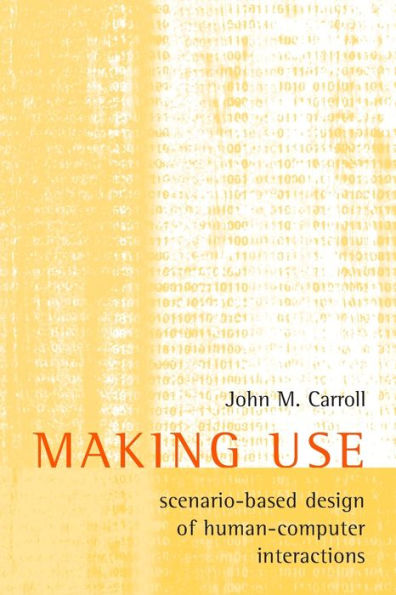
Making Use: Scenario-Based Design of Human-Computer Interactions
382
Making Use: Scenario-Based Design of Human-Computer Interactions
382Paperback
-
PICK UP IN STORECheck Availability at Nearby Stores
Available within 2 business hours
Related collections and offers
Overview
Difficult to learn and awkward to use, today's information systems often change our activities in ways that we do not need or want. The problem lies in the software development process. In this book John Carroll shows how a pervasive but underused element of design practice, the scenario, can transform information systems design. Traditional textbook approaches manage the complexity of the design process via abstraction, treating design problems as if they were composites of puzzles. Scenario-based design uses concretization. A scenario is a concrete story about use. For example: "A person turned on a computer; the screen displayed a button labeled Start; the person used the mouse to select the button." Scenarios are a vocabulary for coordinating the central tasks of system development—understanding people's needs, envisioning new activities and technologies, designing effective systems and software, and drawing general lessons from systems as they are developed and used. Instead of designing software by listing requirements, functions, and code modules, the designer focuses first on the activities that need to be supported and then allows descriptions of those activities to drive everything else. In addition to a comprehensive discussion of the principles of scenario-based design, the book includes in-depth examples of its application.

Product Details
| ISBN-13: | 9780262513883 |
|---|---|
| Publisher: | MIT Press |
| Publication date: | 01/01/2003 |
| Pages: | 382 |
| Product dimensions: | 6.00(w) x 9.00(h) x 1.40(d) |
| Age Range: | 18 Years |
About the Author
Table of Contents
Preface1 The Sorcerer's Apprentice
Example: Designing a Multimedia System
Guiding and Coordinating Discovery
Example: Designing a Library System
Identifying the Real Problem
Thriving on Design
2 What is Design?
Clarifying the Problem
Identifying Design Moves
Envisioning the Solution
Recognizing Trade-offs and Dependncies
Integrating Diverse Knowledge and Skill
Anticipating Impacts on Human Activity
Design Is Hard
3 Scenario-Based Design
What Are Scenarios?
Challenge: Design Action Competes with Reflection
Scenarios Evoke Reflection in Design
Challenge: Design Situations Are Fluid
Scenarios Are at Once Concrete and Flexible
Challenge: External Factors Constrain Design
Scenarios Promote Work Orientation
Challenge: Design Moves Have Many Consequences
Scenarios Have Many Views
Challenge: Technical Knowledge Lags Design
Scenarios Can Be Abstracted and Categorized
Toward a Scenario-Based Framework for Design
4 Example: Video Information System
Raison d'Etre
Clarifying Design Concerns and Objectives
Envisioning Alternative Situations
Managing Consequences and Trade-offs
Creating and Using Design Knowledge
Staying Focused on People and Use
5 Example: Programming Tutorial and Tools
Design Context
Design Analysis
Environment: Bittitalk Browser
Environment: View Matcher
Development:MiTTS
Deployment and Evaluation
6 Usability Rationale
Claims and Requirements for the Touchstone Scenario
Designing and Analyzing a New Touchstone Scenario
Identifying Appropriate Goals
Sustained Learning
Consequences for WorkGroups
The Place of Claims Analysis in Scenario-Based Design
7 Cumulative Design
A View Matcher for Reuse
Principled Emulation of a View Matcher
Activity Modeling in the MoleHill Guru
Genre Specialization in the MoleHill Goalposter
Envisioning and Refining the Goalposter
Design Patterns and Design Models
8 Evaluation and Theory Building
Evaluation Goals and Methods
Evaluating and Developing Design Genres
Attributions to Multiple Theories
Remote and Distributed Causes
Thread-Level Claims
Evaluation-Driven Design
9 Software Development
Object-Oriented Software
Responsibility-Driven Design
Developing Object Models from Scenarios
The Scenario Browser
The Specification-Implementation Gap
10 Finding Scenarios and Making Claims
Where Do Scenarios Come From?
How to Make Claims
Managing Scenarios and Claims
11 Getting Around the Task-Artifact Cycle
Scenario-Based System Development
MiTTS Again
Requirements Development in LiNC
Toward a Scenario-Based Methodology
12 The Scenario Dilemma
Some Status on Scenario-Based Design
Challenges for the Future
No More Sorcerers
References
Index
What People are Saying About This
This book provides a stimulating and thoughtful examination of the complexities underlying the design process of current information technology. Combining the anecdotal with the empirical, and examining success stories as well as design failures, Carroll provides a rich analysis of how decisions are made and methods are applied which frequently fail to produce the desired results for users. In this book he offers a thorough and compelling account of how scenario-based design can both improve the process and advance the theory of design. In articulating and advocating scenario-based approaches Carroll reminds us that good design is, above all, fundamentally grounded in human communication.
Carroll draws on an impressively large body of research to present the mostthorough treatment yet of a powerful idea: employing scenarios to make sureuser interfaces are designed for the way people actually use things.How much easier the world would be if everybody followed his advice.
"Carroll draws on an impressively large body of research to present the mostthorough treatment yet of a powerful idea: employing scenarios to make sureuser interfaces are designed for the way people actually use things.How much easier the world would be if everybody followed his advice."—Jakob Nielsen, Co-Founder, Nielsen Norman Group, and author of DesigningWebUsability: The Practice of Simplicity
Masterfully written, deep, and thoughtful. The book goes directly to the essential questions of HCI design—what will users seeks to accompish, what understanings will they bring, and how can the system respond to users' needs?
Scenario-based deisgn is becoming increasingly recognised as a powerful way of designing new systems. John M. Caroll's latest book, which pulls together work he and his colleagues have been engaged in for the last ten years, is therefore timely. Making Use provides a thoughtful critique of the use of scenarios in design and provides numerous examples that illustrate how a scenario-based approach can provide an integrated focus for design that is informal yet systematic.
